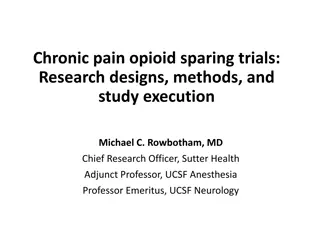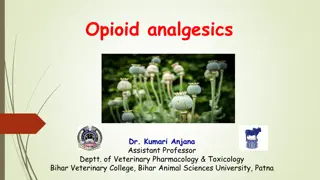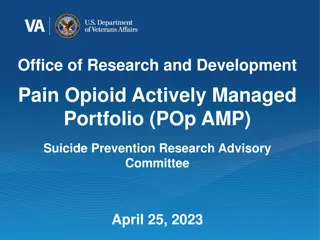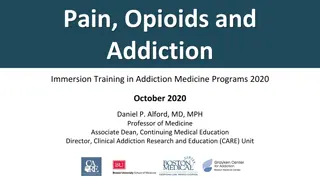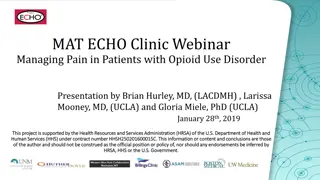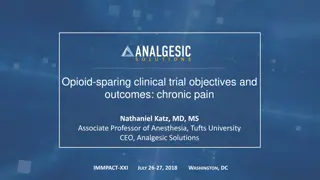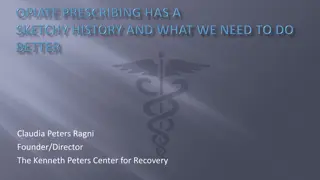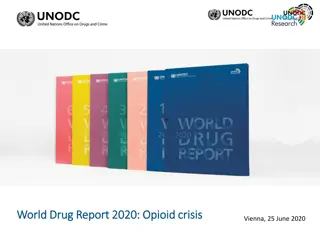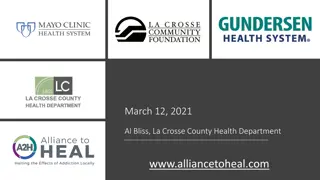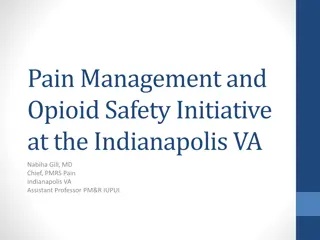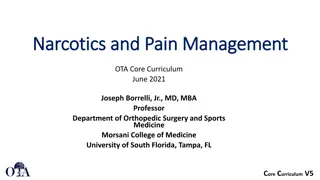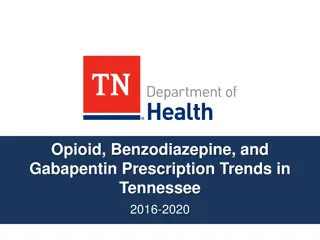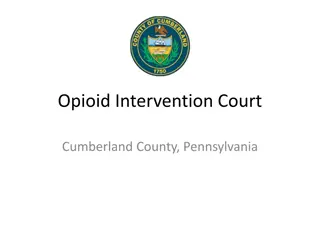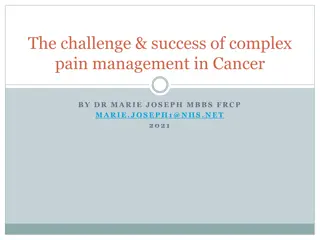Addressing the Opioid Crisis: A Comprehensive Approach to Pain Management
Firefighters and EMTs now carry Narcan to combat opioid overdose, while a clinical perspective reveals challenges in pain management for over 5,000 patients. Issues include inadequate training in pain medicine, leading to unnecessary opioid prescriptions and lack of proper care plans. A solution involves collaboration among healthcare providers, thorough patient assessments, evidence-based treatment plans, and weaning off opioids where possible.
Download Presentation

Please find below an Image/Link to download the presentation.
The content on the website is provided AS IS for your information and personal use only. It may not be sold, licensed, or shared on other websites without obtaining consent from the author. Download presentation by click this link. If you encounter any issues during the download, it is possible that the publisher has removed the file from their server.
E N D
Presentation Transcript
Firefighters/EMT Begin to Carry Narcan Mike Brown Doug Call
Clinical Perspective Handling 5,000 patients, one patient at a time Daniel C. Roth, DO, MBA, MS Summit Pain Management Fort Wayne, Indiana
The Problem Over 5, 000 patients were being seen by clinicians/providers (MD/NP/PA/RN) who had very little to no advanced training or collaboration in pain medicine Patients were not being appropriately assessed for risk, comorbid psychological diseases, and appropriate interventional care Generic/Sham interventional procedures were being performed
The Problem (continued) When the patient got no real benefit, the provider seeing the patient in follow-up would act to try to alleviate the patients pain. This resulted in a very clear and obvious trend of dose-escalation of opioid medications and other concomitant medications. Patient would unknowingly become more and more dependent and tolerant of their opioid medications (not necessarily addicted)
The Problem (continued) Many patients had no imaging (MRI/CT, etc) and no real plan of care for short, moderate and long term, safe and effective pain management. Thus, when the practice was closed abruptly, thousands of opioid dependent/tolerant and some addicted patients were turned loose to fend for themselves (PCP, friends, the street)
The Solution The team of the Allen County Health Department, community ERs, some PCPs, and (surprisingly) few Pain Management Practices . All stepped up to try and care for these patients Full assessment of these patients included their complete history and physical, current medications, proper pain generator diagnosis and closely working with a mental health professional.
The Solution Once a full assessment had been completed, the patient was then started on an evidence-based treatment plan Approximately 1/3 of all patients seen were weaned or immediately discontinued from opiate medication Approximately 1/3 had drastic changes to dosages Approximately 1/3 stayed at their current dosage while a functional treatment plan was established.
Outcomes Most of the patients referred to us by PCP, ER, Allen County Department of Health, self-referral, stayed in our practice. Many of them are on significantly lower or no opioid medications Some of the patients who had severe aberrant behaviors or addictions got into appropriate mental health treatment, albeit with significant issue (insurance, etc)
Outcomes Many patients were treated with the appropriate interventional procedures including; Transforaminal Epidural Steroid Injections Facet Joint Rhizotomies Kyphoplasty Spinal Cord Stimulation
TFESI http://www.aptcmd.com/wp-content/uploads/TF%20injection.jpg
Key Points Crisis required collaboration Careful assessment of these patients revealed many therapeutic opportunities that had not previously been utilized.
Mental Health Response Facilitating Providers Referrals for Addiction Kristian Johnson Connie Kerrigan Marcia Haaff
Clinical Response Care Navigators 800 Number Partial Hospitalization for Addiction Faith Based Intensive Outpatient Program Pain Management Program (Cleveland Clinic Model) Partial Hospitalization for Pain Management (in development)
Mental and Behavioral Health Needs Assessment Recommendations Address issues of access, including: Improving resource and referral networks; Sustaining care until positive therapeutic outcomes can be realized; Balancing personal cost and investment with realities Expanded and accessible services beyond case management and intake assessments in non-urban counties
Mental and Behavioral Health Needs Assessment Recommendations Address issues of access, including: Address needs of families with mental illness amongst family members; Seeding a systemic approach; Supporting schools to become reliable referral resources; Addressing stigmatization
Reducing the Risk of HIV and Hepatitis C Needle Exchange Program Deborah A. McMahan, MD
Why Needle Exchange Program Well if things weren t bad enough In Scott County (pop 4,500) over 180 cases of HIV (most co-infected with Hepatitis C) identified Largest IVDU related HIV outbreak in decades IN THE COUNTRY Now what?
Needle Exchange Program A needle exchange program (NEP) is a harm reduction strategy that allows injecting drug users (IDUs) to obtain hypodermic needles and associated paraphernalia at little or no cost.
Principles of Harm Reduction "Harm reduction aims to keep people safe and minimize death, disease, and injury from high risk behavior. Harm reduction involves a range of support services and strategies to enhance the knowledge, skills, resources, and supports for individuals, families and communities to be safer and healthier.
The Process to Open in Indiana Senate Bill 461 outlines process Outbreak established County government approves State Health Commissioner approves Engage local law enforcement and public officials and community to ensure all on same page with respect to evidence.
Community Concerns Do needle exchange programs encourage IVDU in a community? No. According to Surgeon General Dr. David Satcher: "After reviewing all of the research to date, the senior scientists of the Department and I have unanimously agreed that there is conclusive scientific evidence that syringe exchange programs, as part of a comprehensive HIV prevention strategy, are an effective public health intervention that reduces the transmission of HIV and does not encourage the use of illegal drugs."
Community Concerns Do needle exchange programs increase crime? No. A study presented in the Journal of Public Health found a lack of association of overall and type- specific arrest data with NEP implementation and argues against the role of needle exchange programs in increasing crime rates.
Community Concerns Do needle exchange programs encourage addicts to seek care? Studies since 1997 have demonstrated that individuals in areas with needle exchange programs have an increased likelihood of entering drug treatment programs. -
Community Concerns Are needle exchange programs effective? According to the Centers for Disease Control, the one-time use of sterile syringes remains the most effective way to limit HIV transmission associated with injection drug use Supported by AMA, Surgeon General, HHS, WHO, CDC, etc.)
Components of NEP Provision of NEP Kits Collection of used needles Screening for HIV, Hepatitis B and C Education about safe practices and HIV and Hepatitis Provision of Immunizations for those with Hep C or B Referrals for other services including Mental health and addiction HIP Other services
Kits 30 syringes. Filter needles- 1 cc 28 gauge inch (http://catalog.bd.com/nexus- ecat/getProductDetail?productId=329410) Alcohol swab-30 Tourniquets-3 Sterile water-2ml Cookers-2 Condoms-5 Band-Aids-10 Anti Biotic Ointment-5
Kits Include sharps box for used needle return Entire kit costs about $5 Remember to educate that it is not just the needle that spreads HIV and Hep C
Key Points Engage stakeholders and community to provide current evidence about NEPs Provide screening and mental health and addiction services Include both needle/syringe and other necessary materials to reduce risk of Hep C



